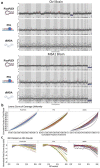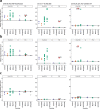This is a preprint.
Single-cell somatic copy number variants in brain using different amplification methods and reference genomes
- PMID: 37609320
- PMCID: PMC10441336
- DOI: 10.1101/2023.08.07.552289
Single-cell somatic copy number variants in brain using different amplification methods and reference genomes
Update in
-
Single-cell somatic copy number variants in brain using different amplification methods and reference genomes.Commun Biol. 2024 Oct 9;7(1):1288. doi: 10.1038/s42003-024-06940-w. Commun Biol. 2024. PMID: 39384904 Free PMC article.
Abstract
The presence of somatic mutations, including copy number variants (CNVs), in the brain is well recognized. Comprehensive study requires single-cell whole genome amplification, with several methods available, prior to sequencing. We compared PicoPLEX with two recent adaptations of multiple displacement amplification (MDA): primary template-directed amplification (PTA) and droplet MDA, across 93 human brain cortical nuclei. We demonstrated different properties for each, with PTA providing the broadest amplification, PicoPLEX the most even, and distinct chimeric profiles. Furthermore, we performed CNV calling on two brains with multiple system atrophy and one control brain using different reference genomes. We found that 38% of brain cells have at least one Mb-scale CNV, with some supported by bulk sequencing or single-cells from other brain regions. Our study highlights the importance of selecting whole genome amplification method and reference genome for CNV calling, while supporting the existence of somatic CNVs in healthy and diseased human brain.
Conflict of interest statement
Competing interests SWS received research support from Cerevel Therapeutics. SWS is a member of the scientific advisory board of the Lewy Body Dementia Association and the Multiple System Atrophy Coalition. FJS receives research support from Genentech, Illumina, PacBio and Oxford Nanopore. All other authors declare no competing interests.
Figures





Similar articles
-
Single-cell somatic copy number variants in brain using different amplification methods and reference genomes.Commun Biol. 2024 Oct 9;7(1):1288. doi: 10.1038/s42003-024-06940-w. Commun Biol. 2024. PMID: 39384904 Free PMC article.
-
Somatic CNV Detection by Single-Cell Whole-Genome Sequencing in Postmortem Human Brain.Methods Mol Biol. 2023;2561:205-230. doi: 10.1007/978-1-0716-2655-9_11. Methods Mol Biol. 2023. PMID: 36399272
-
Robust high-performance nanoliter-volume single-cell multiple displacement amplification on planar substrates.Proc Natl Acad Sci U S A. 2016 Jul 26;113(30):8484-9. doi: 10.1073/pnas.1520964113. Epub 2016 Jul 13. Proc Natl Acad Sci U S A. 2016. PMID: 27412862 Free PMC article.
-
An evolving view of copy number variants.Curr Genet. 2019 Dec;65(6):1287-1295. doi: 10.1007/s00294-019-00980-0. Epub 2019 May 10. Curr Genet. 2019. PMID: 31076843 Review.
-
Identification of Somatic Mutations From Bulk and Single-Cell Sequencing Data.Front Aging. 2022 Jan 3;2:800380. doi: 10.3389/fragi.2021.800380. eCollection 2021. Front Aging. 2022. PMID: 35822012 Free PMC article. Review.
References
-
- Leija-Salazar M., Piette C. & Proukakis C. Review: Somatic mutations in neurodegeneration. Neuropathol. Appl. Neurobiol. 44, 267–285 (2018). - PubMed
-
- Proukakis C. Somatic mutations in neurodegeneration: An update. Neurobiol. Dis. 144, 105021 (2020). - PubMed
-
- Bizzotto S. & Walsh C. A. Genetic mosaicism in the human brain: from lineage tracing to neuropsychiatric disorders. Nat. Rev. Neurosci. 23, 275–286 (2022). - PubMed
-
- Gawad C., Koh W. & Quake S. R. Single-cell genome sequencing: current state of the science. Nat. Rev. Genet. 17, 175–188 (2016). - PubMed
Publication types
Grants and funding
LinkOut - more resources
Full Text Sources
Miscellaneous
